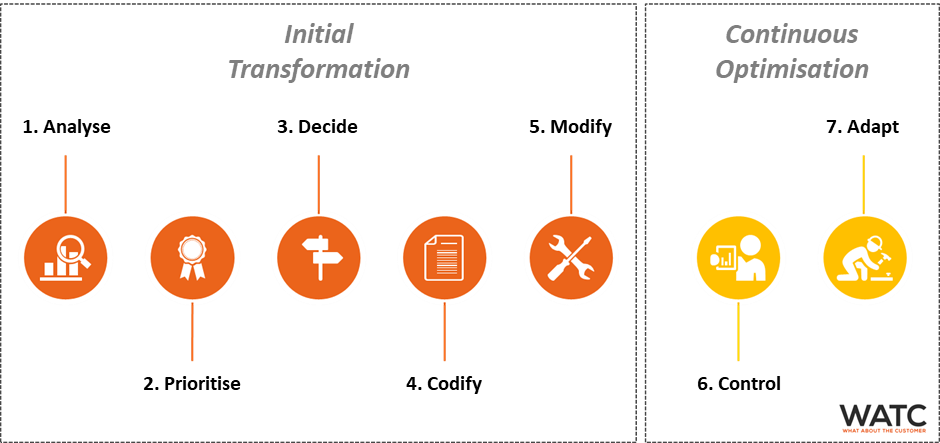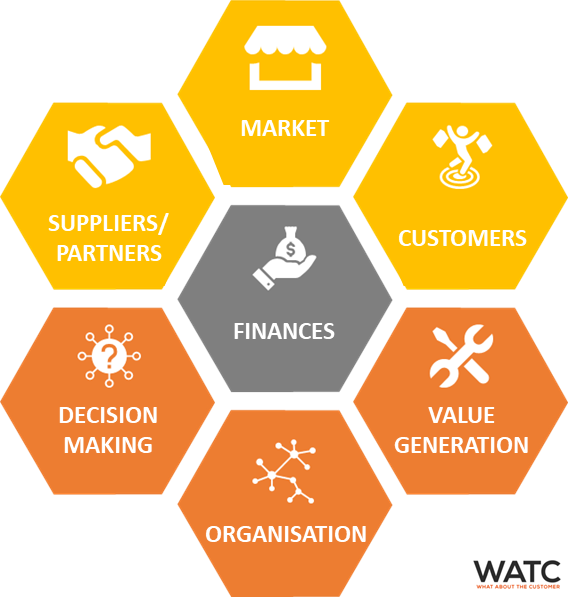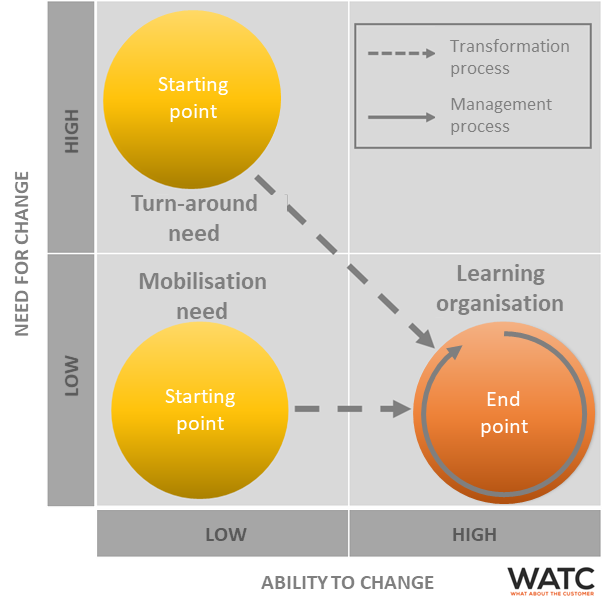Organisations striving for customer centricity face two main challenges: to become customer-centric and to stay customer-centric. Our 7 steps towards a customer-centric organisation cover both the becoming – i.e. the initial transformation – and the staying – i.e. continuous optimisation. In our experience from more than twenty years of working with clients around the world, successful transformation and optimisation require the following seven steps.
(Eine Deutsche Version dieses Artikels finden Sie hier.)
- Analysis of the degree of customer centricity of the organisation
- Prioritisation of required actions
- Decisions about …
- the target situation after transformation
- the best way to achieve this target situation
- the ideal setup for getting there
- Codification of the transformation plans
- Modification towards a customer-centric organisation
- Ongoing Controlling
- Continuous adaptations as a learning organisation
Steps one to five of this process describe the initial transformation of the organisation. Steps six and seven are concerned with the ongoing optimisation that is one of the characteristics of truly customer-centric organisations. They therefore form an integral part of the management and governance processes of any customer-centric company.

INITIAL TRANSFORMATION
1. Analyse
The starting point of any transformation is a deep analysis of the current situation inside and outside the company. It builds the foundation for prioritising the most important fields of actions and for setting up the target system of the transformation process. This target system serves as a guideline for the transformation process and as the basis for assessing its success.

Our customer centricity scorecard has proven helpful both for guiding this analysis phase and setting up controlling routines in step six. For more information on the customer centricity scorecard refer to an article dedicated to this topic that will be published soon.
2. Prioritise
In most cases, the analysis will lay bare a multitude of construction sites that need to be addressed. Quite often there are challenges in all three vital areas of customer centricity – customer information-based decision making, inclusive organisation and mutual value creation. It would be unwise, however, to over-stretch the organisation with too much change at one time. Hence, it is important to prioritise consciously and to distribute individual change projects over time.
3. Decide
Once a company has decided which challenges to address first, it needs to take important decisions regarding execution. These decisions include – among many others – the following topics:
- Target situation:
- Which target state do we want to achieve?
- What will have changed from the viewpoint of all internal and external stakeholders?
- How will we gauge whether we have achieved our target state?
- Required change:
- Which steps lead us to the aspired target situation?
- How profound will the change be for the individual parts of the organisation?
- Which processes and organisational elements will be affected?
- Prerequisites:
- Which magnitude of financial and personnel resources will we require?
- The cooperation of which key people and functions will be necessary?
- Which risks are associated with the aspired change and how can they be mitigated?
4. Codify
To make decisions conveyable within the organisation and to enable a consequential measurement of success, transformation plans need to be written down as concretely as possible. We recommend doing so in two different documents: the roadmap and the playbook. The roadmap describes the transformation of the organisation itself towards more customer centricity. It describes the future state in terms of skills, mindset, way of working, systems and tools as well as the activities required to get there.
The second document describes how the relationship to customers will be modified or developed. It contains a description of the aspired type of customer relationships and which activities the organisation will have to undertake to enhance the value both for customers and for the company. We call this document playbook.
5. Modify
Once the transformation plans have been written down in the roadmap and the playbook, the organisation can start transformation. And this is where it really gets difficult. This transformation is a typical change management process. Levers that can be pulled can be structural (strategy, structure, processes, resources, technologies), cultural (symbols, norms and values, shared beliefs) or targeted at the individual (skills, rolls, behaviour). As with any change project, there are plenty of stumbling stones. In our work with companies all around the world we observe the following six most often:
- Missing consideration of the human aspect: a lack of understanding that resistance to change is inevitable and that the change manager needs to be prepared for it
- Weaknesses in change management: no effective creation of a burning platform and ownership among the key agents of change
- Inept management of the transformation process: missing foresight where the transformation process could stall and a lack of support and enablement of key change agents
- Inept management of the transformation process: missing foresight where the transformation process could stall and a lack of support and enablement of key change agents
- Underestimation of the required patience: missing understanding that change takes time and that the organisation will only play along, if the change manager does not lose steam
- No institutionalisation of the new way of working and thinking: too little anchoring of the aspired state in processes, structures and the cultural
(An article about building a customer-centric mindset by INSEAD business school well captures the institutionalisation aspect of the last bullet point above.)
CONTINUOUS OPTIMISATION
Steps one to five will bring an organisation from a more or less dramatic starting point to a state of improved customer centricity. Steps six and seven constitutes the litmus test of customer centricity: its institutionalization. Is the organisation capable of staying customer-centric? Therefore, the five transformation steps are followed by two management steps that form an inherent part of customer centricity: ongoing controlling and continuous adaptation to an ever-changing environment.
6. Control
Ongoing controlling forms the indispensable foundation for making decisions based on facts, which is one of the pre-requisites for being customer-centric. We define ongoing controlling as the targeted institutionalisation of routines for gathering, analysing, processing and reporting of information as well as for deriving corrective action. This requires the following three elements:
- Consistent use of relevant KPIs for leading the organisation and assessing success
- Clearly defined controlling processes and responsibilities
- Availability of the required tools and systems
7. Adapt
Continuous adaptation requires that an organisation has the willingness and ability to change; not only when external pressure is becoming too strong. Customer-centric companies see it as an inherent part of their business to adapt to an environment that never stops to develop. This way of thinking describes a learning organisation, that constantly monitors its environment, continuously gauges its own customer centricity and adapts to new situations over and over again.

Such a learning organisation keeps the need for dramatic change low and at the same time trains its staff in dealing with change. A learning organisation does not tackle change processes when it cannot avoid change any longer. It sees transformation as a key element of its management and value generation processes.
Many of the topics covered in this article about the 7 Steps towards a customer-centric organisation will be published in more detail in future editorials or have already been issued. Check out our online resources for more blog posts, publications or client impact stories.




